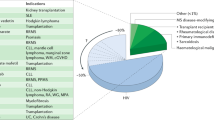Abstract
In the era of the AIDS pandemic, progressive multifocal leukoencephalopathy (PML) has ceased being a rare disease. Prevalence estimates from clinical and pathological series suggest that up to 5% of all HIV-infected persons will develop PML. The extraordinary frequency with which PML attends HIV infection vastly exceeds its appearance in association with other predisposing conditions and has resulted in it no longer being considered a rare disorder. Why PML appears to be far more common with AIDS than with other underlying immunosuppressive conditions remains unexplained. Potential explanations include an alteration of the CNS milieu by HIV facilitating JC viral entry into the brain and activation of the JCV by HIV proteins, e.g., tat, and by inflammatory byproducts of HIV infection. It is quite likely that multiple diverse mechanisms are at play.
Similar content being viewed by others
References
Antinori A, Ammassari A, et al (2001). Epidemiology and prognosis of AIDS-associated progressive multifocal leukoencephalopathy in the HAART era. J NeuroVirol 7: 323–328.
Astrom K, Mancall E, et al (1958). Progressive multifocal leukoencephalopathy. Brain 81: 93–127.
Bedri J, Weinstein W, et al (1983). Progressive multifocal leukoencephalopathy in acquired immunodeficiency syndrome. N Engl J Med 309: 492–493.
Berger JR, Chauhan A, et al (2001). Epidemiological evidence and molecular basis of interactions between HIV and JC virus. J NeuroVirol 7: 329–338.
Berger JR, Kaszovitz B, et al (1987). Progressive multifocal leukoencephalopathy associated with human immunodeficiency virus infection. A review of the literature with a report of sixteen cases. Ann Intern Med 107: 78–87.
Berger JR, Pall L, et al (1998). Progressive multifocal leukoencephalopathy in patients with HIV infection. J NeuroVirol 4: 59–68.
Bernick C, Gregorios JB (1984). Progressive multifocal leukoencephalopathy in a patient with acquired immune deficiency syndrome. Arch Neurol 41: 780–782.
Brooks BR, Walker DL (1984). Progressive multifocal leukoencephalopathy. Neurol Clin 2: 299–313.
Centers for Disease Control and Prevention (CDC) (1997). Update: trends in AIDS incidence—United States, 1996. MMWR Morb Mortal Wkly Rep 46: 861–867.
CDC (2002). U.S. HIV and AIDS cases reported through June 2001. HIV/AIDS Surveillance Rep 13: 1–41.
Chi D, Henry J, et al (2000). The effects of HIV infection on endothelial function. Endothelium 7: 223–242.
Couraud PO (1998). Infiltration of inflammatory cells through brain endothelium. Pathol Biol (Paris) 46: 176–180.
Dubois V, Moret H, et al (1998). Prevalence of JC virus viraemia in HIV-infected patients with or without neurological disorders: a prospective study. J NeuroVirol 4: 539–544.
Dworkin MS, Wan PC, et al (1999). Progressive multifocal leukoencephalopathy: improved survival of human immunodeficiency virus-infected patients in the protease inhibitor era. J Infect Dis 180: 621–625.
Gillespie SM, Chang Y, et al (1991). Progressive multifocal leukoencephalopathy in persons infected with human immunodeficiency virus, San Francisco, 1981–1989. Ann Neurol 30: 597–604.
Ho JL, Poldre PA, et al (1984). Acquired immunodeficiency syndrome with progressive multifocal leukoencephalopathy and monoclonal B-cell proliferation. Ann Intern Med 100: 693–696.
Holman RC, Janssen RS, et al (1991). Epidemiology of progressive multifocal leukoencephalopathy in the United States: analysis of national mortality and AIDS surveillance data [see comments]. Neurology 41: 1733–1736.
Ives NJ, Gazzard BG, et al (2001). The changing pattern of AIDS-defining illnesses with the introduction of highly active antiretroviral therapy (HAART) in a London clinic. J Infect 42: 134–139.
Janssen RS (1997). Epidemiology and neuroepidemiology of human immunodeficiency virus infection. In: AIDS and the nervous system. Berger JR, Levy RM (eds). Lippincott-Raven: Philadelphia, PA, pp 13–37.
Katz DA, Berger JR, et al (1994). Progressive multifocal leukoencephalopathy complicating Wiskott-Aldrich syndrome. Report of a case andreview of the literature of progressive multifocal leukoencephalopathy with other inherited immunodeficiency states. Arch Neurol 51: 422–426.
Kure K, Llena JF, et al (1991). Human immunodeficiency virus-1 infection of the nervous system: an autopsy study of 268 adult, pediatric, and fetal brains. Hum Pathol 22: 700–710.
Kurtzke J, Kurland L (1983). The epidemiology of neurologic disease. In: Clinical Neurology. Harper & Row: Philadelphia, PA, pp 1–14.
Lane JH, Sasseville VG, et al (1996). Neuroinvasion by simian immunodeficiency virus coincides with increased numbers of perivascular macrophages/microglia and intrathecal immune activation. J Neuro-Virol 2: 423–432.
Maschke M, Kastrup O, et al (2000). Incidence and prevalence of neurological disorders associated with HIV since the introduction of highly active antiretroviral therapy (HAART). J Neurol Neurosurg Psychiatry 69: 376–380.
Messite J, Stillman S (1996). Accuracy of death certificate completion. JAMA 275: 794–796.
Miller JR, Barrett RE, et al (1982). Progressive multifocal leukoencephalopathy in a male homosexual with T-cell immune deficiency. N Engl J Med 307: 1436–1438.
Nath A (November 11, 2002). Personal communication regarding the absence of adhesion molecule expression in AIDS-associated PML brain sections.
Persidsky Y (1999). Model systems for studies of leukocyte migration across the blood-brain barrier. J NeuroVirol 5: 579–590.
Sacktor N, RH Lyles, et al (2001). HIV-associated neurologic disease incidence changes: Multicenter AIDS Cohort Study, 1990–1998. Neurology 56: 257–260.
Tate LG (1994). Personal communication regarding PML in the Broward Medical Examiner’s office.
Tornatore C, Berger JR, et al (1992). Detection of JC virus DNA in peripheral lymphocytes from patients with and without progressive multifocal leukoencephalopathy. Ann Neurol 31: 454–462.
Williams KC, Hickey WF (1995). Traffic of hematogenous cells through the central nervous system. Curr Top Microbiol Immunol 202: 221–245.
Author information
Authors and Affiliations
Corresponding author
Additional information
This work has been reported in the Proceedings of the Basic, Clinical and Epidemiological Studies of Progressive Multifocal Leukoencephalopathy: Implications for Therapy Meeting, sponsored by the National Institute of Mental Health, National Institute of Neurological Diseases and Stroke, and the Office of Rare Diseases, July 25–26, 2002, Portland, Maine, USA.
Rights and permissions
About this article
Cite this article
Berger, J.R. Progressive multifocal leukoencephalopathy in acquired immunodeficiency syndrome: Explaining the high incidence and disproportionate frequency of the illness relative to other immunosuppressive conditions. Journal of NeuroVirology 9 (Suppl 1), 38–41 (2003). https://doi.org/10.1080/13550280390195261
Received:
Accepted:
Issue Date:
DOI: https://doi.org/10.1080/13550280390195261




